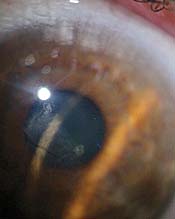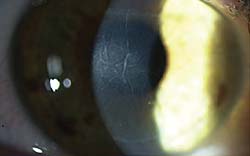Central toxic keratopathy: a new LASIK complication reported
|
|
The art of LASIK has been simplified by the outstanding improvements in technology and the corresponding ease of use. Moreover, with uncorrected visual acuity of 20/20 being reported in nearly 90% of all wavefront-guided LASIK cases, patient expectations are elevated on the same curve as this new technology wave.
LASIK is now safer with newer microkeratomes and more predictable tissue-preserving flap procedures, such as that seen with the IntraLase femtosecond laser (IntraLase, Irvine, Calif.). We also see a reduction in the already low threat of infection when LASIK is used in conjunction with the new fourth-generation fluoroquinolones. Yet, we must not let our guards down. LASIK is surgery, and there still exists the risk of postoperative complications.
A qualified and competent surgeon will address most intraoperative surgical complications. However, once the patient leaves the surgery bed, there still continues to be a risk for early postoperative complications. Numerous articles have been written about flap displacements, abrasions, striae and diffuse lamellar keratitis (DLK). This patient experienced a new complication — central toxic keratopathy (CTK).
The case
CJ, a 44-year-old female executive, came to the office for a preoperative evaluation from her comanaging doctor. Her manifest refraction was –6.50 +0.75 x 89 in the right eye and –5.25 +0.75 x 90 in the left eye, which corrected her visual acuity to a sharp 20/20. Colvard pupillometry was 7.0 mm, ultrasound pachymetry was 524 µm in the right eye and 533 µm in the left eye, Tono-Pen (Medtronic Ophthalmics, Jacksonville, Fla.) IOP was 16 mm Hg in both eyes and the slit lamp exam (SLE) and retinal exam were unremarkable.
CJ had a custom IntraLASIK procedure, combining the IntraLase with the CustomCornea (Alcon, Ft. Worth, Texas) wavefront-guided treatment, with a surgical aim of plano in both eyes. The surgery was uneventful, and the patient was released to return for a 1-day postoperative visit, using Vigamox (moxifloxacin 0.5%, Alcon) three times daily in both eyes, Econopred Plus (prednisolone acetate suspension 1%, Alcon) four times daily and Acular LS (ketorolac solution 0.4%, Allergan) four times daily for 1 week.
At the 1-day visit, CJ had uncorrected visual acuity of 20/50 in both eyes with no complaints of pain or discomfort. Both flaps were viewed on SLE as centered and smooth, with 2+ inflammatory haze in the inferior aspect of the interface. Working under the presumption that this inflammatory haze was grade 1-2 DLK, the patient was instructed to increase her prednisolone usage to hourly, continue with the other drops and return to the clinic the next day.
|
|
|
Opacity in the left eye: This 3-mm dense opacity was not visible without the aid of the slit lamp and had a cracked glass appearance. |
At the 2-day visit, CJ’s uncorrected visual acuity actually improved to 20/30 in the right eye and 20/40 in the left eye, while the DLK spread superiorly and was elevated to a grade 3. CJ underwent a bilateral irrigation of the inflammatory debris; this was accomplished by lifting the flap and scraping the debris from the stromal bed and under the flap. The drop regimen was continued with hourly dosing of prednisolone and usage of Vigamox and Acular LS. CJ was to return again the next morning.
On the 3-day visit, CJ felt that her uncorrected visual acuity was subjectively improved; however, the objective measurement was still 20/30 in the right eye and 20/40 in the left eye. The corneal appearance of both eyes had significant reduction in the inflammatory haze, yet there persisted a diffuse grade 1 inflammatory reaction. CJ brought her husband to this visit and expressed concern about the fate of her eyes. I described the improvement and the general course of DLK, reassuring CJ that continuing on the drop regimen should decrease the potential of any sight-threatening condition.
With DLK still present, CJ continued the same drop regimen and returned for her 4-day postop visit with mixed feelings of encouragement and discouragement. The uncorrected visual acuity was 20/30 in the right eye, and the left eye was now reduced to 20/200. SLE of the eyes was void of any inflammation; however, localized areas of dense white stromal tissue inferior temporal in the right eye and central in the left eye were present. The 3-mm dense opacity in the left eye was not visible without the aid of the SLE and had a cracked glass appearance.
Similar in appearance to the left eye opacity, the right eye opacity was slightly smaller and off center. A preliminary manifest refraction of the left eye produced a correctible acuity of to 20/25–1 with –1.75 +0.25 x 15 20/25–1. No improvement was noted in the right eye refraction. CJ was informed of this change in corneal appearance and the accurate diagnosis of CTK in both eyes.
CTK: no known cause
First described at the American Society of Cataract and Refractive Surgery meeting in 2002 by Robert Maloney, MD, CTK is an uncommon manifestation of a toxic reaction to the corneal bed. It is a focal white lesion appearing within the cornea during the first few days after LASIK. As seen with CJ, this lesion is only appreciable during the SLE and is not seen by the naked eye — most likely a result of the light diffraction at the stromal bed. Similar in appearance to DLK, the manifestation of CTK can easily confuse the clinician.
CTK is caused by a toxic reaction to a foreign substance and is not inflammatory, as DLK is. While no inflammatory process is involved, it is not uncommon to see a concurrent course of DLK. No known cause has been attributed to CTK, yet it is hypothesized that a toxic effect on the cornea, possibly caused by yet not limited to the photoactivation of Betadine (povidone-iodine 10%, Purdue Frederick) by the excimer laser, creates damaging free radicals. CTK needs to be differentiated from grade 4 DLK because the course of treatment varies.
CTK causes a marked hyperopic shift, involves the flap and/or the bed, is non-inflammatory, always has striae present, does not respond to steroids and can be seen after photorefractive keratectomy. In fact, treating CTK patients with long-term use of topical steroids will have no significant effect on the toxic reaction and will only serve to increase the potential for steroid-induced glaucoma. Moreover, lifting the flap and irrigating the interface will provide no relief because the keratopathy is not confined to the interface.
Prevention is critical
|
|
Because no real treatment can cure this toxic reaction, prevention at the time of surgery is critical. Precaution should be taken to ensure that nothing potentially toxic gets under the flap; thus, copious irrigation is recommended before the microkeratome flap is made. Without being present in the operating room, the postoperative LASIK doctor must closely monitor any suspicious inflammatory appearance or corneal opacity.
As seen with CJ, DLK may also be a manifestation of the toxic reaction; the concomitant use of steroids or potential need to irrigate the inflammation is still indicated. In my experience, hourly use of prednisolone acetate suspension or switching the patient to Lotemax (loteprednol etabonate 0.5%, Bausch & Lomb) should continue until all the inflammation has cleared. The CTK lesion, when left untreated, seems to resolve after a period of 6 to 9 months. Patients may still experience a hyperopic shift, however this can be treated by an enhancement.
CJ represents the variability that can be seen with CTK patients. Although she had a central focal opacity in the left eye, her right eye opacity was temporally displaced. Moreover, CJ appears to respond to a myopic correction in her left eye. Having personally treated four patients with CTK, I have not seen a patient who was not hyperopic to some degree. I surmise that the myopic correction is an optical irregularity and that CJ will follow the same course as my previous patients.
CTK is self-limiting, and the postoperative doctor needs to provide the reassurance and confidence that CTK will ultimately resolve. At 6 weeks postop with an uncorrected visual acuity of 20/20-3 in the right eye and 20/40-2 in the left eye and a manifest refraction of –1.00 DS 20/25+1, CJ is again confident that she will reach the crest of her vision potential.

![Marc Bloomenstein, OD, FAAO [photo]](/~/media/images/news/print/primary-care-optometry-news/2004/07_july/bloom_60_90_75417.jpg) Marc
Bloomenstein, OD, FAAO, is a Primary Care Optometry News
Editorial Board member and refractive clinic medical director at Barnet Dulaney
Perkins Eye Center, Phoenix. He can be reached at 4800 N. 22nd St., Phoenix, AZ
85016; (602) 955-1000; fax: (602) 508-4744; e-mail:
Marc
Bloomenstein, OD, FAAO, is a Primary Care Optometry News
Editorial Board member and refractive clinic medical director at Barnet Dulaney
Perkins Eye Center, Phoenix. He can be reached at 4800 N. 22nd St., Phoenix, AZ
85016; (602) 955-1000; fax: (602) 508-4744; e-mail:


